Terry Laughlin's Blog, page 3
November 2, 2019
How To Make Your Stroke More Efficient in Only 10 Minutes
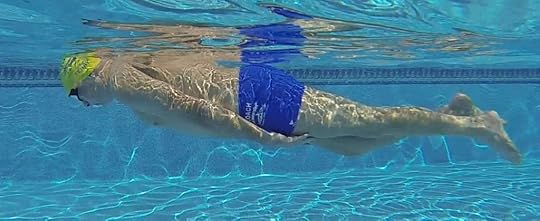
This post was originally published by Terry Laughlin on July 9, 2015.
Would you like to make your stroke markedly, noticeably more efficient in as little as 10 minutes? Doing the right drill, in the right way, can achieve stroke transformation faster than any other means. Here’s a summary of “First Principles” of maximizing the value and efficacy of stroke drills from my recent series of posts on this topic:
The only reason for doing a drill should be to improve your swimming . . . in “real time,” during and immediately after the drill. In other words, after a short period of practicing a drill—generally less than 10 minutes–your stroke should feel noticeably better. Or you should at least have heightened awareness of subtler aspects of your stroke–to work on via Focal Points, while swimming whole stroke.
Never do a drill by rote or on autopilot. Always be aware of (a) how it is specifically meant to improve your stroke; and (b) what stroke thoughts will create that improvement and what sensations confirm the desired improvement is occurring.
Do the drill only long enough (with respect to both the duration of each drill rep and the number of reps) to create a “sense memory” to guide you during whole stroke. Never continue to the point where you lose intensity of focus or the drill becomes a kicking exercise, rather than a skill builder.
Here’s an example of how we design and teach TI drills to observe those principles. For our example, I’ve chosen Torpedo, our simplest drill and the one we teach first. For what purpose did we design it, and how should you practice it to achieve that purpose?
Torpedo Drill
Torpedo is the first drill in what we call our “Comfort and Body Control” drill series. These drills and skills teach three qualities essential to efficiency –and to creating the conditions for long-term improvement:
Immediate energy savings from a weightless and stable body position.
The body control necessary to learn all subsequent skills.
The focus, sense of calm, and habits of self-perception that will make your swimming more satisfying and effective for decades to come.
Torpedo practice repeats are briefer than any other drill—usually about 6 seconds. And you’ll probably only practice it a few times—for a lifetime cumulative duration of as little as 30 minutes. Nevertheless, it can create invaluable and enduring body awareness that improves Balance and Core Stability—the indispensable foundations of an efficient stroke.
One reason we like Torpedo as a introductory drill is that it has few “moving parts.” This allows pinpoint focus on three key mini-skills—a “weightless” head, head-spine alignment, and an engaged core. Isolating your head in front heightens awareness of when your head is truly “weightless” and aligned with the spine. We also use Torpedo to initiate awareness of how it feels to engage core muscle while you swim. Both skills are essential to maintaining a sleek, stable body position when you begin moving your arms and legs.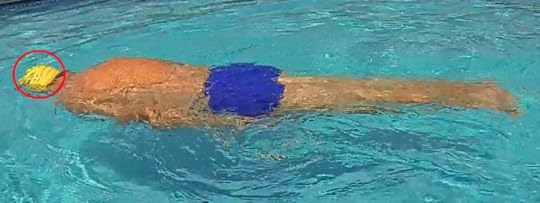
Before doing Torpedo in a horizontal gliding position, we have students rehearse good posture in a standing position. Then we proceed to live practice.
How to Practice Torpedo
Push gently into a surface glide.
Your legs may sink gradually as glide slows. Maintain head-spine alignment as they do.
Lightly press legs together to increase glide and slow legs from sinking.
When you lose momentum (in a few seconds) stand for a breather and mental reset. Then push into glide again.
[Note: You can use a gentle flutter to maintain momentum and body position for just a few seconds longer–allowing sensations to imprint a bit longer. Stop if your kick feels like work.
Torpedo Focal Point Checklist
Head: Release its weight so you feel the water support (or cushion) it.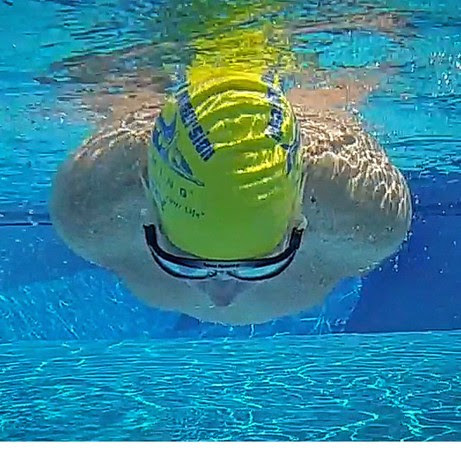
Arms: Push hands far down the front of your thighs—arms should mold inside bodyline.
Core: Pull navel toward spine. Feel curve in lower back flatten slightly.
Legs: Press together and lengthen. If legs drift toward bottom, as momentum slows, don’t fight it. DO maintain head-spine alignment.
Bodyline: Maintain the strong posture from your rehearsal.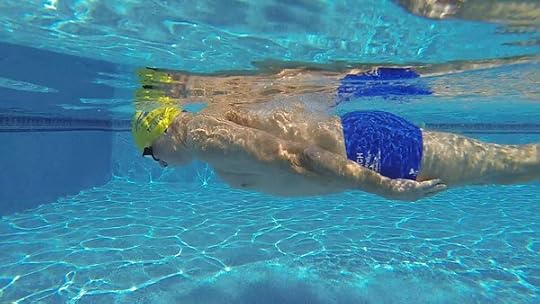
Improve Your Stroke in 10 Minutes
Repeat Torpedo as described four to eight times. Total elapsed time should be just two to three minutes. Then practice whole stroke—just five to six strokes without breathing. Focus solely on replicating the sensation of a weightless/cushioned and stable head from Torpedo. After each, stand for a breather and mental reset. Repeat 4x. Elapsed time two to three minutes–a total of five minutes on this sequence of drill + whole stroke.
Then repeat the 5-minute sequence above with a focus on good posture with an engaged and stable core.
Total elapsed time for both: About 10 Minutes. Stroke Improvement: Priceless!
This is how drills should work—always!
Transform Your Entire Stroke in Two Months or Less
Learn Torpedo and other guaranteed skill-builders with our downloadable Ultra-Efficient Freestyle Self-Coaching Toolkit. The drills and skills are illustrated in 15 short videos. Guidance on how to learn and practice each drill effectively–like that provided above–illustrated by clear pictures like those above are contained in the companion Workbook.
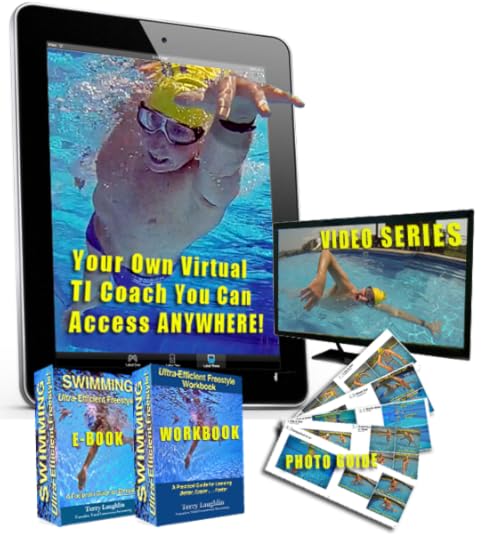
The post How To Make Your Stroke More Efficient in Only 10 Minutes appeared first on Total Immersion.
October 25, 2019
PRACTICE SETS: Two Sets To Test Your Stroke Efficiency and Mastery
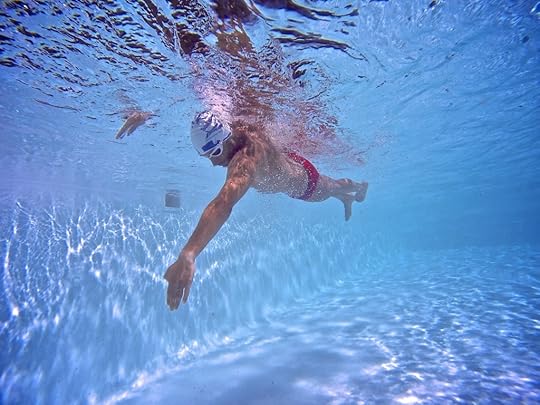
This post was originally published by Terry Laughlin on Aug. 21, 2011.
One of my favorite tuneup sets is also a great test of one’s ability to increase speed efficiently. This, in turn, is one of the best predictors of your ability to pace a race effectively. There are two versions of this set:
Version 1: Maintain Stroke Count (i.e. Stroke Length) unchanged while descending your time (i.e. improving your pace).
Version 2: Maintain Tempo (i.e. Stroke Rate) unchanged while descending your time. For this test set, you’ll need a Tempo Trainer.
You can do this set for any repeat distance, but it will be easier to keep track if you swim repeats of 50 or 100 yds or meters.
In doing both versions I found that I could make far more significant improvements in time while maintaining SPL than while maintaining Tempo. Here are examples taken directly from practices I’ve logged:
Version 1
8 x 100 Descend, controlling stroke count.
I stayed consistent at 75 strokes. I was more relaxed, yet a bit faster, than on a similar set I did last week at 77 strokes. That time I descended from 1:59 to 1:42. Today, taking two fewer strokes, I descended from 1:53 to 1:38. I’m very pleased with being able to swim 15 seconds faster for 100m without adding any strokes.
Version 2
6 x 100 @ tempo of 1.10 seconds/stroke. Try to reduce SPL progressively. (If I do, then speed “happens.” I’m trying to be more efficient. Swimming faster is the result.)
I started at 85 strokes for 100m and finished at 80. I felt exceptionally pleased to be able to subtract 5 strokes on this set. Yet that improved my 100m pace by only 5.5 seconds (I saved 5 strokes; each took 1.1 sec.. This is only 30 percent of the change I was able to effect two weeks earlier when I maintained SPL.
These two sets are really a mirror image of each other.
In Version 1, the task is to increase Stroke Rate, while keeping Stroke Length unchanged. (Note:When I did the first set, I wasn’t trying to increase SR. I simply tried to “find” more speed as artfully–not physically--as possible and the increase in SR just “happened.”)
In Version 2, the task is to increase Stroke Length while keeping Stroke Rate constant. (Note: In this instance I was overtly and specifically trying to increase Stroke Length. Without highly conscious effort, it simply doesn’t happen.
What does this mean?
1) Stroke Rate is far more “plastic” than Stroke Length. Which is more of a useful moment of clarity than a startling insight.
2) That you can easily increase Stroke Rate without trying. In fact, doing so accidentally, heedlessly and ineffectively is an almost universal “condition” of human swimmers when they try to go faster. But you can only increase Stroke Length with a conscious, and usually quite demanding effort.
I invite you to try both: How much can you descend without adding strokes? Another day, repeat the same series, but keeping Tempo constant instead. How much can you descend now?
I also suggest you try Version 2 at different tempos. I did it today at 1.10. I’ll try again at 1.15, 1.20 and perhaps 1.25 and see whether a slower tempo allows a larger improvement in time.
Find more tips like this in the Ultra-Efficient Freestyle Handbook, a richly-illustrated, easy-to-read 140 page guide to understanding freestyle technique in depth. It comes along with 15 downloadable videos and a learning and practice workbook in our Self-Coaching Toolkit.
The post PRACTICE SETS: Two Sets To Test Your Stroke Efficiency and Mastery appeared first on Total Immersion.
October 18, 2019
5 Principles for Continuous Improvement… for Decades!
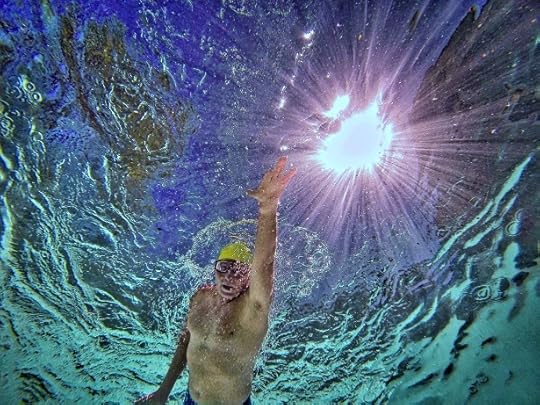
Editorial Note: This post from the old TI Discussion Forum is archived from 2012, but if you’d like to participate in the current TI Discussion Forum, it is now located on Facebook as “Total Immersion Swimming Technique Discussion Group.”
This post was originally published by Terry Laughlin on Feb. 11, 2012.
The TI Discussion Forum had a query from Werner this morning, who I’m guessing is from Germany. Werner wrote:
Hallo,
I’ve been “on the TI train” for 12 months. Thanks to TI and this Forum I was able to complete 1000 meters of continuous freestyle within six months. My anxious question is: Will it hold?
Is it like biking? My grandma didn’t ride a bike for 55 years but was able to do so again, when someone suggested she do so. So how long will my current swimming success hold?
Thanks for sharing your experiences,
Werner
Here’s my reply to Werner:
Welcome to TI and thanks for engaging with other members of this Forum. As you will soon discover, your fellow TI swimmers are a thoughtful, supportive and generous group and will eagerly share the lessons they’ve learned.
The simplest answer to your question is: No, it will not hold. Quite the contrary, it will improve. Continuously. And likely for decades, not just weeks, months or years. The key is to embrace the most important aspect of the TI philosophy and methodology — Kaizen [continuous, life-long improvement].
Here are 5 Core Principles of Kaizen Swimming:
1) Your goal in every pool session is to improve your swimming – not to complete a certain number of meters or raise your heart rate or any of the traditional goals. As I’ve written many times, “My main thought every time I enter the pool is to be a better swimmer when I leave it an hour later.”
2) Improve by finding and fixing weak points. Those will be more obvious — and easier to fix – in the early stages, and more subtle — and require more patience and more strategic thinking later.
3) Love the “plateau.” This will become more important a few months to a year after you start TI, as the improvements take longer to achieve. You’ll spend weeks, and eventually months, practicing without being conscious of any improvement. During these times, maintain faith that change IS taking place — at the level of neurons. After a period of time that change will consolidate and produce a thrilling forward leap.
4) Become passionately curious. Swimming is the most complex, challenging and non-instinctive of all physical skills. This is because it’s an aquatic skill, while humans are terrestrial mammals. If you tirelessly seek to expand your knowledge and understanding, you’ll enjoy swimming much more, make steadier progress, and be able to have great confidence in your choices.
5) Practice is its own reward. Whatever goals have motivated you to begin swimming, strive to progress to a point where those external goals — while remaining sources of motivation — essentially become beside the point. The motivation that brings you to the pool day after day, year after year, decade after decade is the knowledge that your practice is the high point of your day, it leaves you energized mentally and physically for everything else you do, and–over time–produces enduring positive change in body, mind and spirit.
Happy Laps,
Terry
Find more tips like this in the Ultra-Efficient Freestyle Handbook, a richly-illustrated, easy-to-read 140 page guide to understanding freestyle technique in depth. It comes along with 15 downloadable videos and a learning and practice workbook in our Self-Coaching Toolkit.
The post 5 Principles for Continuous Improvement… for Decades! appeared first on Total Immersion.
October 4, 2019
Permission to Swim Slowly: 3 Ways to Artfully Cultivate Smart Speed
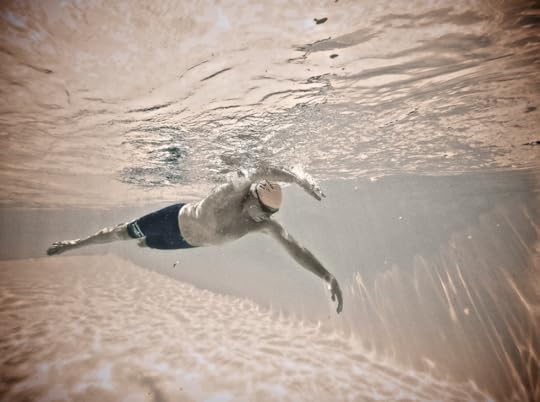
This post was originally published by Terry Laughlin on December 14, 2012.
In a post on the TI Discussion Forum forum [from the 2012 archive], Steve asked:
“My practices are limited to 100-meter repeats because I get too winded to swim farther. Though I can swim as much as 2000 meters in a pool session, I still need to stop and rest every 100 meters. How can I swim farther without becoming winded?”
Craig Arnold, a TI enthusiast from the UK replied:
“When swimming a longer distance, why don’t you call it a warm up? That way, you give yourself permission to swim more slowly. Swim with a balance focus, concentrating on a weightless head, then marionette arms, with no splashing or bubbles. When I start out that way, before I know it I’ve swum 1000 meters.”
Craig gives good advice, but his phrase “permission to swim more slowly” is especially powerful. Though I began swimming 47 years ago, it took me over 40 years to give myself permission to swim more slowly.
My good friend Amby Burfoot, the 1968 Boston Marathon champion, long-time editor in chief of Runner’s World for 30 years–and a TI swimmer since turning 60–revealed to me that world-class Kenyan marathoner runners typically warm up for a race at a pace of about 9 minutes per mile—barely more than half their racing speed.
Compared to the Kenyans’ ability to run slowly, I was pretty poor at swimming slowly. At that time, my racing pace for the 1650-yard free was about 1:15 per 100 yards. I realized I never swam at anything remotely close to 2:30 per 100. All of my swimming was in a narrow window between 1:15 and 1:30 per 100. Immediately I decided that henceforth, I would start most practices with up to 10 minutes of swimming at the e-a-s-i-e-s-t pace possible.
The effect was instantaneous. I felt and swam much better in everything that followed. As it happens, my “superslow” pace turned out to be only a few seconds slower. I was amazed how little speed I sacrificed when I went much easier.
Striving to achieve a state of profound relaxation at the start of practice resulted in several surprising benefits:
1. I became hypersensitized to the interaction of my body and the water. I felt as if I was aware of the water at the molecular level.
2. My balance and stability were far better tuned — and I could feel the difference at every faster speed.
3. To swim faster after those initial laps of deep ease, I didn’t have to push the throttle. My pace seemed to pick up effortlessly as I continued.
Within a few months I had swum the 1650 in a pace of 1:12 per 100. Giving myself permission to swim slower made a clear difference in enabling me to swim faster.
Teaching regularly in an Endless Pool, I’ve found it’s a rare student who knows how to swim well . . . slowly. Students who would finish far behind me in a race cannot keep from crashing into the front of the pool when I set the current at moderate speeds. They find it eye-opening when I turn the current way down and swim in place with impeccable form and no interruption in rhythm.
I explain that there’s a wide spectrum of both power and tempo. The vast majority of swimmers constantly push the upper—or physical–end of the spectrum and ignore the lower—or artful—end. It’s at the lower end where you learn most about how to form a partnership with the water.
3 Specific Ways To Swim Slower
1) Observe your hand speed as you begin your stroke. Allow a moment-of-stillness after you reach full extension, then begin stroking at slowest possible speed and lightest possible pressure.
2) Explore how slowly you can bring your arm forward over the surface, without discontinuity in recovery or instability in balance.
3) If you swim with a Tempo Trainer, turn it down gradually. Can you maintain flow at a tempo of 1.80 strokes per second?
I promise you’ll discover these are exacting skills requiring great focus and great body control. And therefore invaluable to swimming any faster speed.
Find more tips like this in the Ultra-Efficient Freestyle Handbook, a richly-illustrated, easy-to-read 140 page guide to understanding freestyle technique in depth. It comes along with 15 downloadable videos and a learning and practice workbook in our Self-Coaching Toolkit.
The post Permission to Swim Slowly: 3 Ways to Artfully Cultivate Smart Speed appeared first on Total Immersion.
September 27, 2019
PRACTICE SET: Guaranteed to Develop “Smarter” Hands and Improve Your Grip on the Water
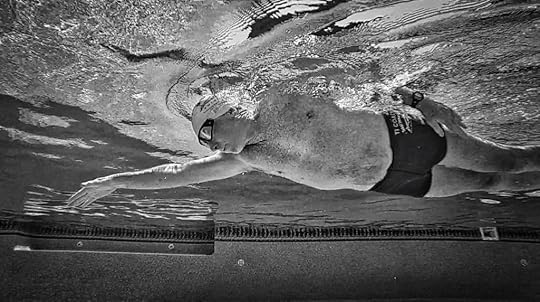
Photo credit: Bob Fagan and USIA Video
This post was originally published by Terry Laughlin on Mar. 22, 2011.
Like previous practices posted, this is another example of a technique-focused Mindful Swimming Practice. These are similar to a series of classes led by me and other TI Coaches at the Multisport World Expo [in 2011] for some 160 swimmers at MIT. All showed visible and measurable improvement– in some cases improving stroke efficiency by over 30%, in others improving 1500m pace by as much as 6 minutes – in just over an hour.
All attendees expressed enthusiasm for being exposed to a refreshing alternative to uninspiring workout formulas based only on how hard or long. One set of classes was based on thoughtfully choreographed series of Focal Points (Mindful Swimming), the other on using Tempo Trainer and Stroke Count exercises to discover combinations of Stroke Length and Rate to create faster paces with less effort.
This practice is devoted entirely to increasing sensitivity and awareness of how your hands enter, extend and find a grip.
Warmup/Tuneup 300 “Add Fingers”
Do a continuous 300 or 12 x 25 or anything in between. Do 2 rounds of the following series:
25 Fist, 25 1-finger, 25 2-fingers, 25 3-fingers, 2×25 Full hand.
Focus: Round 1, concentrate on improving your sense of holding water as ‘grip’ area increases. Round 2, you may count strokes instead. Or both.
Narrow Focus Swim 6 to 8 x 25 of any 3 of the following Focal Points. Practice those you choose in the order given.
Hang Hands Keep hands relaxed (not stiff) with fingers loosely separated (not closed).
Mail Slot Cut a ‘slot’ in the water with fingertips. Slip forearm through that slot.
Bubble-Free Watch for bubbles as you extend. Try to eliminate if you see.
Light and Lazy Hand should feel weightless as it floats ‘lazily’ forward.
Wide Tracks After Mail Slot entry, extend your relaxed hand so outside of wrist and elbow bones are wide of your shoulder. Avoid the center.
VW Beetle Visualize the hood of a VW Bug. Slide your hand across the hood and down to the bumper as you extend.
Patient At full extension, pause hand for a nanosecond before stroking. Begin pressing back as slowly and gently as possible.
Combined Focus Combine your three focal points as follows:
2 rounds of [3 x 50 (50 of each) + 2 x 75 (25 of each)]
Test your ability to transition smoothly from one focus to another and sense a distinct difference in your stroke as you do.
Extended Focus
Choose favorite Focal Point and swim [4 x 25 + 3 x 50 + 2 x 75 + 1 x 100]
Test your ability to sustain both focus and an improved sensation for a gradually increasing distance or duration.
Optional: Do this set a second time with Tempo Trainer set at a tempo of your choosing. Rather than count SPL, do this to test whether the addition of Tempo beeps aid in maintaining focus.
See closeups of Mail Slot, Bubble Free, Light and Lazy, Wide Tracks, Relaxed Hands from :20 to 1:20 of this video:
The post PRACTICE SET: Guaranteed to Develop “Smarter” Hands and Improve Your Grip on the Water appeared first on Total Immersion.
September 20, 2019
The Truth about 5 Common Swimming Myths
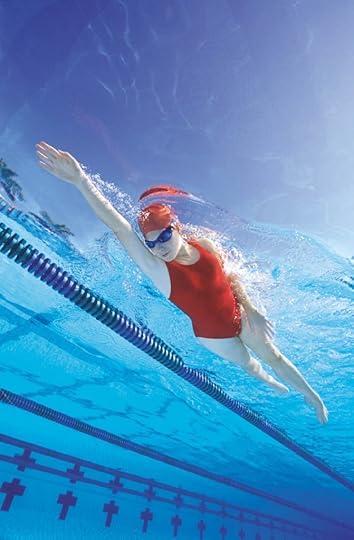
This blog was originally published by Terry Laughlin on Aug. 24, 2015.
The primary reason the average swimmer converts only 3 percent of energy into forward motion is that our swimming actions are so strongly influenced by basic self-preservation instincts. Concerns about choking and sinking are so primal that they continue to affect how we swim long after we’ve lost our conscious fear and even after we’ve become quite accomplished.
What else could explain why Sun Yang lifts and cranes his head, noticeably twisting his body even while setting a 1500-meter world record?
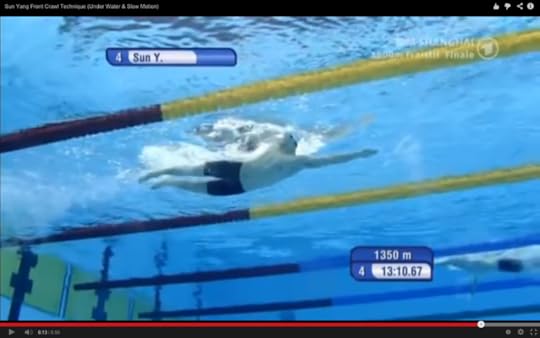
Though this ungainly moment passes so quickly that you probably wouldn’t notice it on the surface, he repeated this several hundred times during his 1500m world record. How much time might it have cost him to distort his bodyline over and over?
Why does he still do that? It’s most likely this habit began to form when he was still a new swimmer, perhaps 6 years old. Eventually he hid it well enough that his coaches overlooked it. But if a world record holder can still waste energy in such an obvious way, how likely is it for the rest of us to avoid doing so?
My post Most of What You ‘Know’ about Swimming is Wrong! explains how most of the advice we receive about swimming is likely to reinforce our existing wasteful instincts. We’re less likely to critically examine questionable advice when it agrees with what our own instincts already incline us toward.
The converse of this is: Actions that can significantly improve your swimming are most likely counterintuitive. As examples, consider five common myths and their non-instinctive counterpoints.
Myth: To swim fast, you must ride high on the water.
This myth arose because elite sprinters seem to have more of the body out of the water. In fact, hydroplaning occurs only at speeds of 30mph or greater, while no human has ever swum faster than 5mph. What we’re actually seeing is the swimmer cutting a deeper bow wave. This requires so much energy that it’s almost impossible to sustain for more than a minute.
Fact: On average, a human body, rides 95 below the surface. (How much of Sun Yang’s body is below the surface in the picture above ? As he swims 1500m faster than anyone in history!) We swim through, not over, the water. Consequently drag avoidance, not power production, is our most important strategy for swimming faster.
Myth: Keep the water at your hairline. Partially due to influence from TI, this formerly universal notion is finally changing. Why did coaches teach this for so long? They said it would . . . help you ride higher on the water. In fact, the opposite is true.
Fact: The head represents about 8 percent of body mass. So if most of it is above the surface, other body parts must sink. This causes us to kick more, greatly increasing drag and energy waste. Because the head has many cavities, it is quite buoyant. Focus on feeling that your head rests on a ‘cushion’ of water and aligns with your spine —a universal principle of good biomechanics, demonstrated by Katie Ledecky at the World Championships in Kazan Russia.
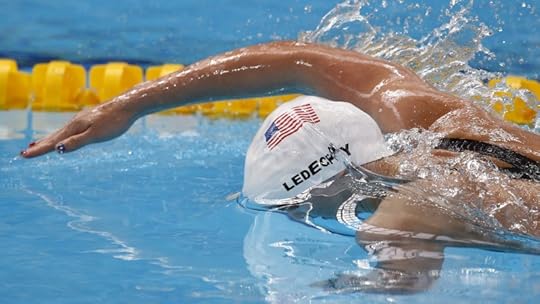
Myth: Push water back (past your thigh . . . and/or faster in the last third of your stroke.) Various versions of this encourage you to focus on pushing back—whether farther, harder, or faster. For the vast majority of swimmers these actions create far more turbulence than propulsion. They also make you tired because they put the workload on using arm and shoulder muscles, rather than tapping core power.
Fact 1: The most important contribution of the hand and arm is to reduce drag. To accomplish this, focus on using your arms to extend your bodyline and separate the molecules in front of you, rather than on pushing on the molecules behind you. This reduces wave drag–the most significant limiter of Stroke Length and speed.
Fact 2: When focused on propulsion, use your hand to hold your place, instead of to push water back. The world’s best swimmers move the body past the hand. (In fact when Doc Counsilman filmed Mark Spitz in 1968, he was astonished to see that Spitz’s hand exited the water ahead of where it went in.) They can do this because they (i) excel at ‘active streamlining;’ and (ii) apply pressure with great precision–but surprisingly little force–as shown by a study of 1992 Olympic swimmers.
Myth: Kick to keep your legs from sinking. Kick even more to swim faster. Because of our survival instinct to churn the arms and legs, we need little encouragement to overdo this. Nonetheless we hear advice from all sides to kick more and harder. From the swim instructor who hands us a kickboard at our first lesson, to coaches who believe no workout is complete without a set devoted to pushing a kickboard up and down the pool, there’s a universal mania for kicking.
Fact: The legs are awesome at burning energy and creating drag, but almost pathetic at creating propulsion. Doc Counsilman (again) studied the effects of kicking among elite swimmers in the 1960s and found that kicking increased drag, and contributed nothing to propulsion at speeds above 5 feet per second—a thoroughly pedestrian pace for top swimmers. Like the arms, your legs make their greatest contribution by drafting behind the upper torso. Unless your goal is to sprint a short distance, you can hardly go wrong by kicking less. You’ll not only reduce drag and save energy. You also allow your legs to be drive more by core-body action than by fatigue-prone thigh muscles.
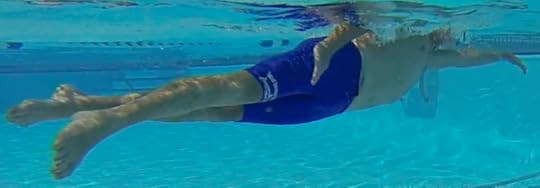
Myth: Stroke faster to swim faster. Like each of these myths, I subscribed to this as a young swimmer and it took me more than a decade—from age 38 to about 50–to fully undo the habit. We churn the arms from our first lap. Instinct also seems to suggest that the ‘obvious’ way to swim faster is to stroke faster. Then there are seemingly authoritative voices who tell us that top triathletes or open water swimmers stroke 70 or more times per minute and therefore we should too.
Fact: Swimming speed is determined by a simple equation: Stroke Length times Stroke Rate equals Velocity (SL x SR = V). You need both to swim faster but SL has conclusively been shown to be the foundation–the measure that correlates most strongly with performance.
To swim faster, first establish your optimal SL (measured by strokes per length or SPL and indexed to your height). Reducing drag is the easiest way to do so. Then incrementally increase SR, while maintaining an efficient SL.
The most precise and controllable way is by using a Tempo Trainer, increasing tempo by as little as one-hundredth of a second to ease adaptation. Increase tempo a tiny bit; maintain your stroke count. When that feels natural and easy, make another tiny tempo increase. Before long the cumulative increase in speed—with a long, relaxed, efficient stroke—will be quite significant. And sustainable.
Be Mindful . . .
As each of these stroke thoughts/skills are counter-intuitive, remember that habit, instinct—and most influences you encounter—will pull you back toward wasteful actions. Making these changes permanent requires conscious, purposeful, and mindful practice.
Find more tips like this in the Ultra-Efficient Freestyle Handbook, a richly-illustrated, easy-to-read 140 page guide to understanding freestyle technique in depth. It comes along with 15 downloadable videos and a learning and practice workbook in our Self-Coaching Toolkit.
The post The Truth about 5 Common Swimming Myths appeared first on Total Immersion.
September 13, 2019
Terry’s Pool Tool Review: Just Say No To Kickboards
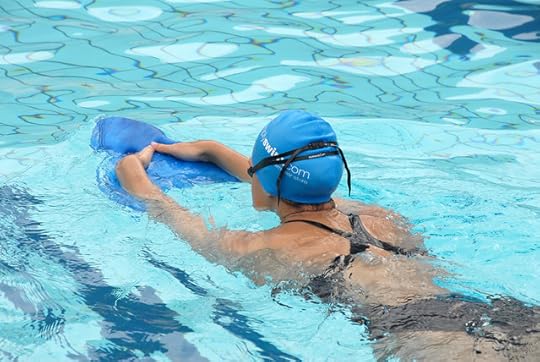
(Photo credit: Simply Swim)
This post was originally published by Terry Laughlin on December 29, 2010.
Here’s the 4th in my series of counter-reviews of “swim tools” featured in the Active swimming newsletter article 5 Tools to Spice Up Your Swimming. Here’s an excerpt from the piece on kickboards: “Kickboards are another staple of the competitive swimming world. When you use fins, kick hard so it becomes aerobically challenging instead of just a gentle cruise up and down the lanes.”
My rating: 1 out of 5 – Use kickboards if you think of the pool mainly as a good place to “get exercise.” Avoid if you hope to improve your swimming.
Unlike paddles, kickboard training poses little risk of injury (unless you do excessive breaststroke kicking). And it’s adequate as a form of general fitness training.
That’s the extent of anything positive I can say on their behalf.
As the article says, they’re a “staple” of the competitive swimming world. I think mania would be a more accurate term. I’d estimate that swimmers worldwide devote a collective 1,000,000 (one million) hours a week to kickboard training, believing it’s good – even essential – for their swimming.
Contrarian that I am, I consider it an appalling waste of human potential.
How did this mass delusion take hold? Blame the “Body Parts Theory of Swimming Mechanics” which goes like this: “You have an Arms Department responsible for pulling you along and a Legs Department responsible for pushing you ahead. Since we train body parts separately in the weight room, do it in the water too.”
Lately it seems many coaches are competing over who can devote more of the workout to plowing up and down on kickboards. With so many leading coaches taking part in an arms, err legs, race, it’s a rare coach or swimmer willing to take the risk of Just Saying No to Kickboards and actually discover whether the apocalypse – or better swimming – results.
In an admittedly anecdotal experiment, I’ve done just that. From 1996 to 1999, while coaching the sprinters at West Point – considered the most “kicking reliant” of all events — we never did a single lap with kickboards.
Surprisingly, no one ever complained that their legs “died” during a race. Not only that, but the group as a whole had off-the-charts improvement and dominated all competition — who were not risking untrained legs.
I swore off kickboards personally nearly 20 years ago. Previously I’d trained as hard and faithfully on kickboards as any teammate. This helped me kick fast repeat times on fast intervals while pushing a kickboard in front of me.
Attempting to use my whole body in races? That was another matter entirely. There, my legs always betrayed me. My kick was ineffective and my legs still fatigued badly.
Since I kicked the kicking sets, on the rare occasions when I attempt a 50 kick, my time is pathetic and the effort exhausts me.
But when I race, my legs now contribute significantly to my speed – and never fatigue. (A result of assiduous work on learning to coordinate a 2-Beat Kick as a part of integrated whole-body movement. But that’s a topic for another blog.)
Which proves that what kicking sets train you to do is push a kickboard across the pool. The best way to train your legs for the role they’ll perform while swimming is to use them while swimming– we call that Whole Stroke.
Master the skills of efficient freestyle with the Total Immersion Effortless Endurance Self Coaching Course!
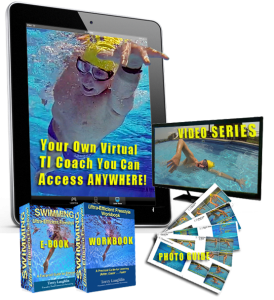
The post Terry’s Pool Tool Review: Just Say No To Kickboards appeared first on Total Immersion.
September 6, 2019
PRACTICE SETS: What’s Your Best Stroke Count? Find Your Ideal Stroke Count Range With This Practice
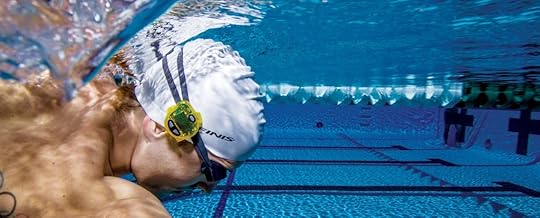
This post was originally published by Terry Laughlin on Mar. 23, 2011.
This practice is one of a series of sets inspired by the classes we gave at the Multisport World Expo at MIT on March 19. It segues from Tempo Trainer sets designed to help you expand your range of available stroke counts – and discover those best for both endurance and speed — to Stroke Calibration sets designed to hone your internal awareness.
Note: For all Tempo Trainer (TT) sets, allow 3 beeps for pushoff; synch 1st hand entry to 4th beep. Allow one extra beep for turns. Synch 1st hand entry after turn to 5th beep.
Tune-up Swim 50 + [6×25] + 50
Swim 50. Count total strokes.
Swim 6 x 25. Odd 25s with index-finger-only extended. Even 25s with “normal” hands.
Compare SPL (Strokes Per Length) one finger to normal hand. Can you reduce the difference between them?
Swim 50 as before. Count total strokes. Did count change?
“Discover” Personal Efficiency Range Swim 10 x 25
Reset TT [Tempo Trainer] each 25: 1.3 – 1.4 – 1.5 – 1.6 – 1.55 – 1.50 – 1.45 – 1.40 – 1.35 – 1.30 sec/stroke
Use this set to improve efficiency (reduce SPL). As tempo slows, you’ll notice extra time in the stroke. Use the extra tenth of a second time to extend a bit further and be more patient about beginning the stroke. When tempo reaches 1.6 sec/stroke, note how many strokes you saved.
As tempo increases again, maintain the sense of length and leisure you gained as tempo slowed. Be stingy about giving back the strokes you saved. On final 25, note difference in SPL from lowest count and from start of set. For every stroke saved from beginning of set, your time for 25 is 1.3 second faster.
Sustain SPL for Distance Choose a comfortable tempo (from range above)
Swim [4 X 25 + 3 x 50 + 2 X 75 + 1 X 100]
Strive to maintain SPL by relaxing as repeat distance increases
Rest 10 beeps between all swims.
An outstanding result would be to add no more than 1 stroke to your SPL on the 25s.
Your most valuable outcome is realization that the most important change to make as distance increases is to deepen focus, not increase exertion. In fact, you need to find a way to relax more. The first 50 of your 100 must be easier than when you only swam 50 yds, in order to maintain SPL/Tempo combination for the full 100.
Faster Tempo
Swim 1 to 2 x 25 each @ 1.20, 1.10, 1.00, 0.90 sec/stroke
What part of stroke feels hurried? Strive to keep catch leisurely as tempo increases.
Can you stay smooth, relaxed and quiet as tempo increases?
One benefit of this exercise is to find the tempo at which your nervous system isn’t adapted. (e.g. If you add one stroke each at 1.2, 1.1 and 1.0, but three strokes at .9, that tells you that tempo is outside your current range.)
Shift Focus
Choose comfortable tempo. Swim 2 to 4 sets of [3×25]. Synch beep to:
Hand Spear for 25
Hip Nudge for 25
Toe-Flick for 25
Repeat.
How does moving synchronization point from front to rear of body change your awareness of the stroke?
Swim Without Tempo Trainer
The following sets test your internal sense for seamlessly adjusting length and rate to accomplish the tasks described.
Stroke Calibration Swim 2 or more rounds of x [6X25].
Choose starting SPL from the range of counts you had between 1.2 and 1.5 tempo. Call this “N.” Each round of [6×25] is: “N”, + 1, + 2, + 1, “N”, – 1
On your first round, you’ll probably have some difficulty estimating length and rate accurately enough to strike the wall in rhythm and at your intended count.
Your goal for succeeding rounds is to:
(1) Calibrate better;
(2) Swim with more awareness;
(3) Feel slightly faster at each SPL.
Speed Variation Swim 2 or more rounds of [2×25]
In each round, #1 is Cruise; #2 is Fast.
Choose any SPL from range in Stroke Calibration set. Your task is to:
1) Swim all 25s at this count.
2) In subsequent rounds increase speed difference without changing SPL.
3) Can you swim both easier/slower AND stronger/faster at same SPL?
AVAILABLE FOR PURCHASE IN THE T.I. STORE:
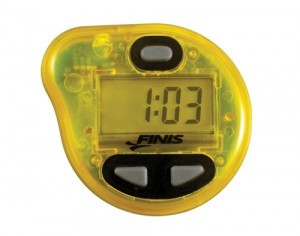
The Tempo Trainer Pro from Finis “cracks the code” on speed.
The Tempo Trainer lets you choose your speed with mathematical precision. First it gives you the physical ability to choose and improve your speed or pace– and that leads to the psychological sense that you do control that, which is priceless to confidence and motivation.
The post PRACTICE SETS: What’s Your Best Stroke Count? Find Your Ideal Stroke Count Range With This Practice appeared first on Total Immersion.
August 23, 2019
Get The Air You Need: A Focal Point Checklist for Breathing
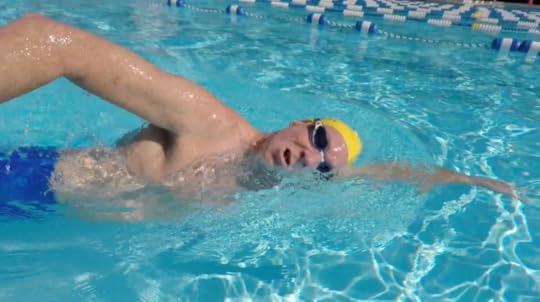
The following article is excerpted from Terry Laughlin’s book “Extraordinary Swimming for Every Body: A Guide To Swimming Better Than You Ever Imagined.”
Unless you have all the air you need, you’ll be too distracted to concentrate on other skills during drill practice or whole stroke swimming. Being mindful of the following will be helpful as you rotate from nose-up to nose-down and back again:
Don’t Hold Your Breath
Begin exhaling immediately. Exhaling with slow quiet nose bubbles is a good way to regulate your breathing and to avoid inhaling water or choking as you breathe.
Relax Into the Water
If you lift your head, it will be harder to get to air. If you keep your head low, it will be easier. And stay relaxed whenever you are rolling up to get air or back down. Moving abruptly in either direction will make your body position less stable.
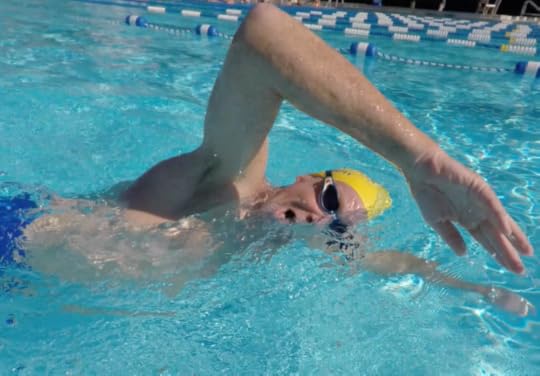
Rhythmic Breathing
Three tips for fitting a seamless rhythmic breath into your stroke, while maintaining good balance and a patient catch:
Follow Your Shoulder
As you spear one arm forward, the opposite shoulder moves back. Just follow this shoulder with your chin and the rotational energy of spearing will make it easier to get air.
Stay Low
Practice this in three ways: (1) Relax into the water as you breathe; (2) Keep the top of your head as close to the surface as possible, while rolling to breathe; (3) Look back slightly over your shoulder as you breathe.
Stay Tall
Give extra care to keeping the lead hand “patient” as you breathe, stroking only after you inhale. And if you keep your fingers tipped down, your next stroke will be far stronger.
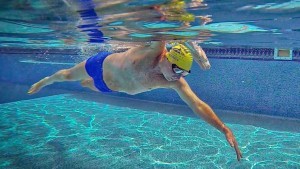
Breathe Two Ways
Alternate-side or bilateral breathing promotes symmetry better than single side breathing. If you breathe only to one side, it’s likely that you’ll veer off the “tracks” in that direction. I try to breathe as often to one side in practice and when racing. Breathing to your unfamiliar side may feel awkward at first, but patient practice will gradually reduce that awkwardness. As well, all the T.I. drills improve symmetry and build a better foundation for efficient bilateral breathing.
To learn more in-depth detail about the breathing mechanics of efficient swimming, check out our video “O2 in H2O: A Self Help Course on Breathing in Swimming”– available as a digital download or on dvd.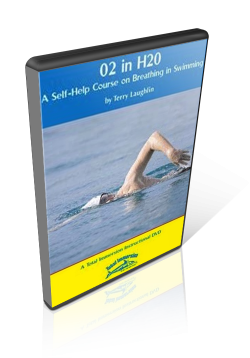 Nothing is more essential to a swimmer than air. Yet few swimmers truly understand how to breathe efficiently… not just to get air, but to integrate breathing seamlessly with the stroke. Breathing is sometimes viewed as a liability or inconvenience, but when you do it right, breathing can actually make your stroke better. This video shows you how, using water bowl exercises, shallow water exercises, skills in drills, and whole stroke breathing skills. Detailed studies with focal points for practice cover these three major strokes: Freestyle, Breaststroke, and Butterfly.
Nothing is more essential to a swimmer than air. Yet few swimmers truly understand how to breathe efficiently… not just to get air, but to integrate breathing seamlessly with the stroke. Breathing is sometimes viewed as a liability or inconvenience, but when you do it right, breathing can actually make your stroke better. This video shows you how, using water bowl exercises, shallow water exercises, skills in drills, and whole stroke breathing skills. Detailed studies with focal points for practice cover these three major strokes: Freestyle, Breaststroke, and Butterfly.
The post Get The Air You Need: A Focal Point Checklist for Breathing appeared first on Total Immersion.
August 16, 2019
How to Swim Faster by Stroking Slower (AND Faster)
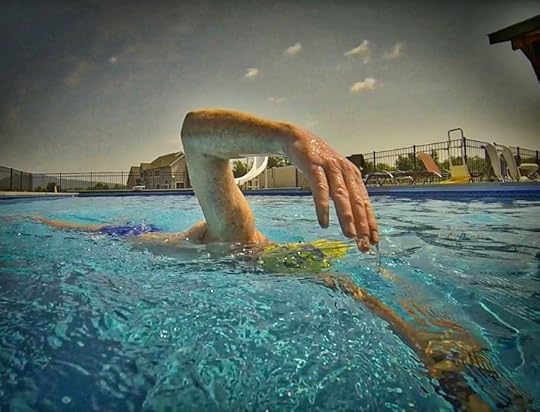
The following post was originally published by Terry Laughlin on February 15, 2013.
Describing swimming as “slow” or “fast” is too imprecise to be meaningful. A pace that is slow for 100 meters can be very fast for 1500 meters. A time that is slow for a 25 year old can be world-record pace for a 75 year old. And even for the same swimmer and distance, “slow” or “fast” tells us surprisingly little.
If I swim a series of 100-yard repeats at a pace of 1 minute 24 seconds that would be nothing to write home about if I swam them at a tempo of 1.0 seconds/stroke (which would be 16 strokes per length.) But I’d feel inclined to shout from the rooftops (or at least post on the TI Forum, Facebook and Twitter) if I swam at a tempo of 1.5 seconds/stroke — which would require me to complete each length in 11 strokes.
Drilling much deeper into the slow/fast dichotomy, have you considered that even within the same stroke, some parts should be “slow” while others should be fast? In fact, the ability to do this–called asynchronous timing–is a high level skill that is critical to swimming your best.
The catch (not the entire stroke) should be as slow as possible–all other things being equal. Taking more time on the catch improves streamline by keeping your bodyline extended a bit longer. It also improves propulsion by allowing you to cultivate a firmer grip and keep the water molecules behind your hand and arm quieter.
With a faster catch, you’re liable to move the water more. With a slower catch, you move your body more. The most notorious example is the anchor leg on the Mens 4 x 100 Freestyle Relay at the 2008 Olympics in Beijing. The main Jason Lezak passed Alain Bernard was his dramatically-slower catch–which resulted in him traveling much farther on each stroke.
In contrast, the recovery should be as quick as possible–all other things being equal. This is because the more time your arm is out of the water–where it weighs 10x more– the more “stress” is imposed on your balance and stability. And thus the more chance you’ll use arms and legs to “steady” yourself. Also the more time the recovery arm is out of water, the more time you spend as a “shorter vessel.”
But here’s the conundrum. You shouldn’t try to speed up your recovery by moving your arm faster. Instead, strive to (i) travel the shortest distance between exit and entry — a straight line with fingertips barely clearing the water; and (ii) have your hand out of water as briefly as possible.
And here’s one more benefit to practicing a super-slow catch: It will improve your Balance and Stability by tuning up spinal-stabilizer muscles.
Master the skills of efficient freestyle with the Total Immersion Effortless Endurance Self Coaching Course!

The post How to Swim Faster by Stroking Slower (AND Faster) appeared first on Total Immersion.
Terry Laughlin's Blog
- Terry Laughlin's profile
- 17 followers



